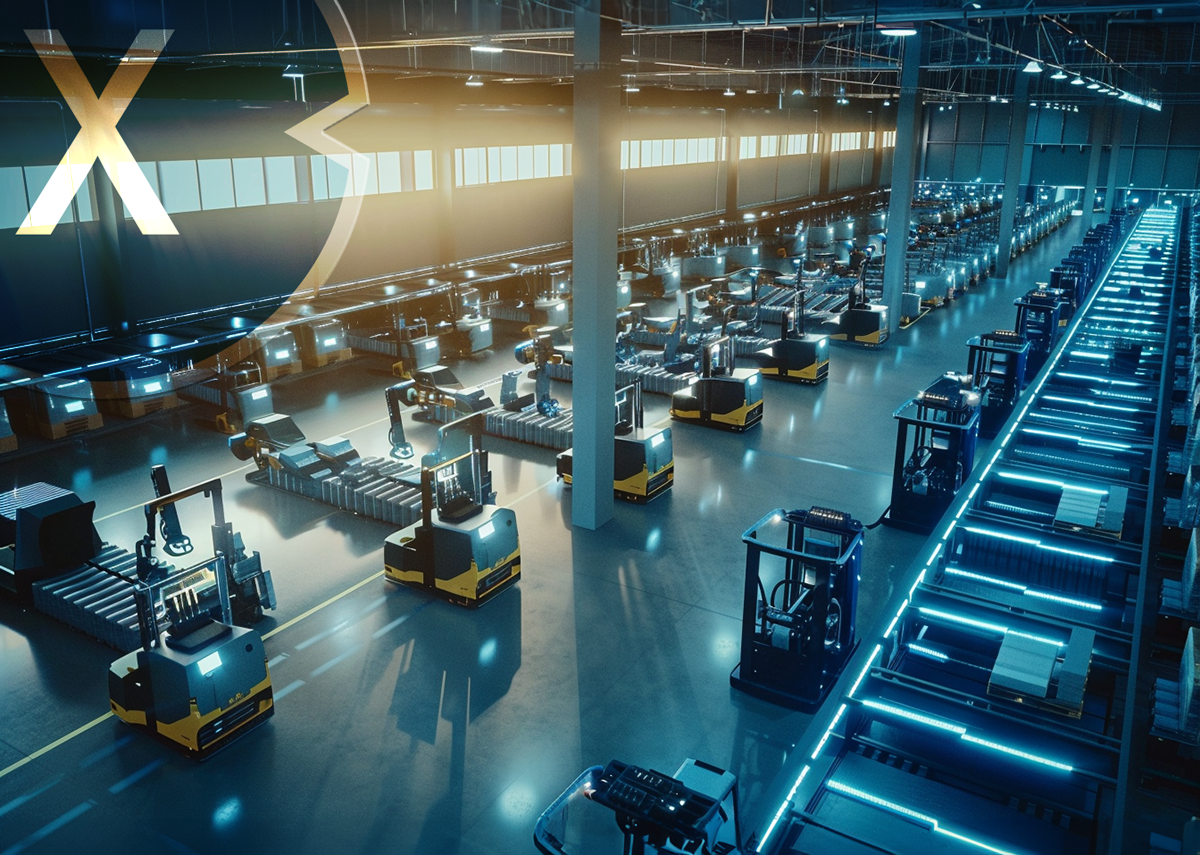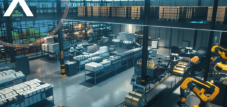
Automation in the warehouse: An urgently needed further development in intralogistics for future viability - Image: Xpert.Digital
✨ The future of logistics: digitalization and automation
📦🚀 Digitalization in logistics is still a dominant topic in the media and companies. Technologies such as artificial intelligence (AI) and the digital twin are shaping today's discussion and setting new standards for efficiency and flexibility in logistical processes. The area of “automation of warehouse and material flow processes” is increasingly becoming the focus of attention. Companies are faced with an acute shortage of skilled workers, which makes the use of automated systems in intralogistics not only attractive but almost inevitable.
🚀 The importance of automation for businesses
In many companies, the shortage of skilled workers and increasing demands for flexibility and customer orientation are leading to increased pressure. Manual work processes often reach their limits and often endanger the existence of the entire company. Against this background, automation represents a solution that allows operational processes to be made more efficient and at the same time more flexible.
However, the use of automation systems is not just a response to the lack of personnel. Rather, it also opens up opportunities to optimize existing processes, reduce costs and increase productivity. Companies that rely on automation gain a competitive advantage because they can respond to customer needs more quickly and efficiently. At the same time, this leads to a reduction in errors that occur more frequently in manual processes, thereby increasing the quality of the goods delivered.
🔧 Challenges and opportunities of automation
But automation not only brings advantages but also challenges. One of the biggest hurdles is the necessary adjustment of personnel qualifications. Employees must be trained to operate and maintain the new technologies. These changes require time, resources and the willingness of the workforce to adopt new working methods.
Another problem is the conversion of operational processes and existing software solutions. Many companies have established systems over the years that now need to be adapted or replaced to meet the requirements of automated processes. The integration of different systems plays a crucial role in ensuring a smooth process.
Despite these challenges, the opportunities outweigh the challenges. Companies that successfully transition to automation benefit from increased efficiency, lower error rates and better adaptability to volatile markets. This allows them to remain competitive in the long term and expand their market position.
🛠️ The right technology and systems for automation
Before deciding which technology or system to use in the warehouse, companies and scientists must consider a variety of factors. There is no “one solution” that is equally suitable for all companies. Choosing the right system depends on the company's individual requirements, such as the size of the warehouse, the type of products stored and the speed at which goods are handled.
The most commonly used technologies in warehouse automation include autonomous mobile robots (AMR), automatic storage systems (AS/RS) and conveyor technology. AMRs are able to move independently through the warehouse and transport goods from one place to another. These robots are particularly flexible and can quickly adapt to new layouts and work processes.
Automatic storage systems, on the other hand, are specifically designed to make optimal use of space in the warehouse and speed up access to goods. They are particularly suitable for companies that require high storage density and at the same time must ensure fast access times.
Conveyor technology also plays a central role in warehouse automation. It enables the automated transport of goods over longer distances within the warehouse and, in combination with other systems such as AMRs or AS/RS, can ensure a seamless material flow.
📈 Development trends in warehouse automation
The trend is clearly towards intelligent automation systems that can make decisions independently with the help of artificial intelligence and machine learning. For example, modern warehouse systems will be able to analyze and optimize flows of goods in order to avoid bottlenecks and shorten delivery times.
A particularly promising area is the use of robots in order picking. Here, robots can not only pick products from shelves, but also assemble, package and prepare orders for shipping. This significantly speeds up the picking process and reduces the error rate.
Another important trend is the networking of warehouse processes. By using IoT technologies (Internet of Things), all devices and machines within the warehouse can communicate with each other. This creates a fully networked warehouse in which all processes can be monitored and optimized in real time. This enables unprecedented transparency and control over the entire material flow.
🎯 Flexibility as the key to success
A central feature of modern warehouse automation is flexibility. Companies must be able to quickly adapt their warehouse processes to changing market requirements. This not only affects the scaling of storage capacities, but also the adaptation of the systems to new products or changed order patterns.
Flexible automation systems offer a decisive advantage here. They can be quickly reprogrammed and adapted to changing requirements without causing long downtimes. This allows companies to increase their efficiency while keeping costs down.
🌟 The future of warehouse automation
Automation in the warehouse will continue to gain in importance in the coming years. Given increasing globalization and growing online commerce, companies are forced to continually optimize their warehouse processes in order to remain competitive.
The integration of technologies such as AI, robotics and IoT will play a crucial role. Great progress can be expected, particularly in the area of artificial intelligence, which will make it possible to make warehouse processes even more efficient. Intelligent systems will be able to make forecasts about future flows of goods and make optimal use of storage capacities.
The digital twin, a virtual representation of the warehouse in real time, will also be used more frequently in the future. With its help, companies can simulate and optimize their warehouse processes before implementing them in the real world. This reduces costs and minimizes the risk of errors.
Overall, it can be said that automation in the warehouse already plays a central role in intralogistics and will become even more important in the future. Companies that invest in these technologies early on and adapt their processes accordingly will benefit from the advantages of automation in the long term and secure their competitiveness.
📊 Increase efficiency and address the challenges of the shortage of skilled workers
Automation in the warehouse offers companies enormous opportunities to increase their efficiency and meet the challenges of a shortage of skilled workers. At the same time, it also requires investments in technology, personnel and the adaptation of existing processes. The decision as to which technology or system to use depends on the individual requirements of the company. Those who master these challenges will benefit from the advantages of automation in the long term and gain a decisive competitive advantage.
📣 Similar topics
- 🤖 Digitalization in logistics
- 📦 Automation in the warehouse
- 🚀 Increasing efficiency through technology
- 🧩 Integration of different systems
- 🛠 Adjustment of staff qualifications
- 🔧 Challenges and opportunities
- 🤖 Intelligent automation systems
- 🌐 Networked warehouse processes
- 📈 Competitive advantage through automation
- 🏭 The future of warehouse automation
#️⃣ Hashtags: #Digitalization #Automation #Efficiency #Technology #Skills shortage
Xpert partner in warehouse planning and construction
We are there for you - advice - planning - implementation - project management
☑️ Smart City & Factory: Industry expert for energetic 5G buildings and halls as well as advice and installation of solar systems
☑️ Xpert.Plus - logistics consulting and logistics optimization
☑️ Industry expert, here with his own Xpert.Digital Industry Hub with over 2,500 specialist articles
I would be happy to serve as your personal advisor.
You can contact me by filling out the contact form below or simply call me on +49 89 89 674 804 (Munich) .
I'm looking forward to our joint project.
Xpert.Digital - Konrad Wolfenstein
Xpert.Digital is a hub for industry with a focus on digitalization, mechanical engineering, logistics/intralogistics and photovoltaics.
With our 360° business development solution, we support well-known companies from new business to after sales.
Market intelligence, smarketing, marketing automation, content development, PR, mail campaigns, personalized social media and lead nurturing are part of our digital tools.
You can find out more at: www.xpert.digital - www.xpert.solar - www.xpert.plus

